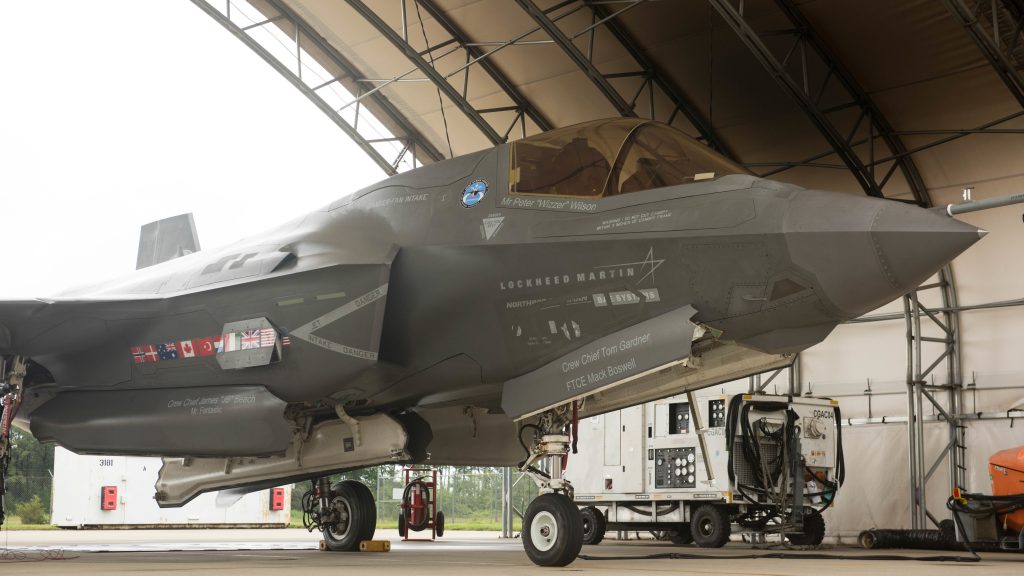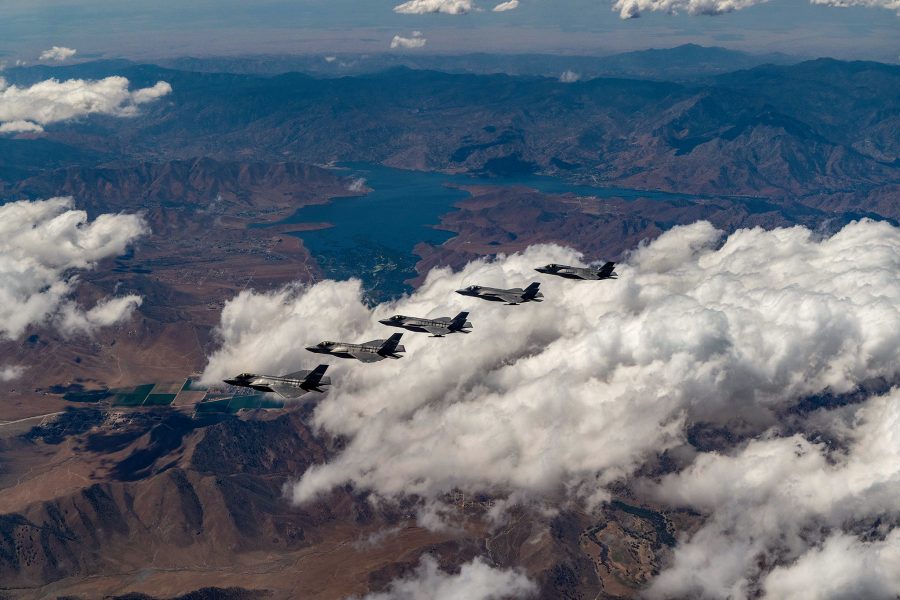The Tech Refresh-3 update of the F-35 fighter may face more delays due to insufficient manpower and test resources and suffers from an unrealistic degree of concurrency, the Joint Program Office director told Air & Space Forces Magazine in an exclusive interview.
What’s more, there was no backup plan in case the TR-3, needed for the much-anticipated Block 4 upgrade, did not deliver on time, said Air Force Lt. Gen. Michael J. Schmidt.
Now “here we are,” more than two years late in delivering the capability, he said Sept. 8.
“I still see risk in front of us,” Schmidt added of the TR-3 update. Although testing of the TR-3 is well underway, the first F-35s built with the new system won’t start reaching the fleet until next year. Schmidt took over the F-35 program in August 2022.
Lockheed Martin, the prime contractor on the F-35, announced last week the first TR-3-equipped jets won’t be delivered until between April and June 2024, after previously saying they would arrive by the end of 2023.
“As a result, we now expect to deliver 97 aircraft in 2023, all in the TR-2 configuration,” the company announced. “We are continuing aircraft production at a rate of 156 per year while simultaneously working to finalize TR-3 software development and testing.”
Schmidt echoed Lockheed in saying the Joint Program Office’s timeline is now April to June. The delays stem from hardware arriving late, software behind schedule, and a late start to flight testing, he said. There are also not enough people working on the program, he added.
The TR-3 update replaces the computational core of the F-35 with a much more powerful processor, which will run the Block 4’s more powerful electronic warfare suite and accommodate a greater number of weapons and classified capabilities. The Air Force has held down the number of F-35s it’s bought in recent years, saying it prefers to wait for the more powerful Block 4 version.
There was an “extremely optimistic” plan for shifting from the TR-2 to TR-3 versions, Schmidt said, with “a lot of assumptions about improvements in time that would be made that did not come to fruition.”
“Block 4 by itself is 80 or so different capabilities. … And we have a plan to put them into various lots, but in my opinion, that plan wasn’t informed by true technical decision-making at critical junctures that said, ‘no kidding, we can get it into this lot,’” Schmidt said. The TR-3 is supposed to go into F-35s built in Lot 15.
Schmidt added that “there’s a lot of concurrency in this program, which is fine. Concurrency … is good, in a lot of cases.”
However, “you need to look at what is the probability” of implementing an update according to schedule, he said, as well as “the consequences of it not being ready on time.” Integrating a new weapon is one thing, while a fleetwide hardware and software change is another.
“We did not have a backup plan with the old hardware,” he said. “We made a decision a number of years ago that we were going to go all-in, and, in my opinion,” given the magnitude of the upgrade, perhaps should not have “made the decision to implement this in Lot 15, or we would have at least had a backup plan before going forward with it. And so here we are … late to need on TR-3.”
While “the hardware is doing pretty well right now, the software integration started late. And so that was a challenge,” he said.
Much of the problem has to do with resources, Schmidt said.
“Our lab infrastructure is not what it needs to be,” he said. “The lab is not fully representative of the flight test environment, and the lab capacity is nowhere near what it needs to be.” Testing is still underway with the latest version of the TR-2 hardware and software, and that’s pulling lab time away from TR-3, he added.
“We’ve got the first version of software for TR-3 in the labs right now and then even the follow-on version of software for TR-3 is in the labs. And they’re literally having to switch the labs over from one to the other, which is a significant amount of time to try to work those things in parallel,” Schmidt said.
On top of that, “our flight test infrastructure is old; it is really old,” he asserted. “We are doing everything we can to limp it along. We have a lot of support from the U.S. and our partners to buy additional flight test airplanes. We should have bought or replaced those aircraft years ago, but here we are.”
There are three dedicated TR-3 test jets coming, Schmidt said, “that were appropriated a couple years ago,” and six more are needed to flesh out the TR-3 test fleet. It hasn’t been decided yet how they will be apportioned among the F-35A, B, and C types.
“We’re not talking about flight test aircraft, I’m talking about Flight Sciences aircraft,” Schmidt said. “So fully wired-up, test aircraft.” Some are targeted for software testing and others are needed for full weapons integration testing.
Then there’s a new Engine Core Upgrade coming, “hopefully, with the support of the Congress, and that will require flight test aircraft as well,” Schmidt said.
As a result, the availability of test aircraft is a limiting factor.

“I still see risk in front of us,” Schmidt said. “We’re not done. We are flying in flight test … almost every day. … I think we’d flown 110 or so TR-3 flights, but you know, we need to get the software stable and to where it needs to be with all of all of the capabilities built into the system, to get it moving forward.”
He would not characterize how the software instability is manifesting, saying only “the software is not as stable as it needs to be and we still have additional capabilities that we need to get some of the deficiencies worked out.”
Asked why the resources to accomplish TR-3 in a timely manner weren’t anticipated, Schmidt said a review last year determined “there was not a good model” for the effort.
“On paper, you can say, ‘I think I need this many humans,’ and those humans cost this many dollars and should take about this much time. The reality is, you don’t always have all the humans that you wish you had,” Schmidt said. “The lab capacity was competing against those other things. … Jets don’t necessarily fly every single day, especially older jets.”
Since then, newer models have been “very telling in terms of our capacity, relative to delivering capability,” he said. Those new models don’t just apply to TR-3, but “we’re now working with a model-based, data-driven discussion on every single capability that we are trying to deliver in this airplane, which is feeding into that that Block 4 contract and what we’re committing to.”
The models for delivering TR-2 were “extremely optimistic,” he said. The resulting delay is now at least “a couple of years from the beginning” but the full delay “all depends on where you start the movie.”
Schmidt would not discuss how the TR-3 situation is affecting contract negotiations for Lots 18 and 19 of the F-35, but he did say there is no urgency to get those negotiations concluded by the end of fiscal 2023 on Sept. 30. There are “an enormous number of things in those conversations,” he added.
A Lockheed spokesperson said the TR-3 “remains our No. 1 development priority” The company is has more than 500 employees, 15 labs, and flight testing at Edwards Air Force Base, Calif., and Naval Air Station Patuxent River, Md., dedicated to the effort.
However, in a statement, Lockheed pointed to the development of the new Integrated Core Processor (ICP) by L3 Harris, a key part of TR-3, as a source of some delays “due to unexpected challenges associated with hardware and software development, component and system integration testing and system qualification testing. The hardware development challenges impacted hardware/software integration, compressing the software testing schedule.”
Lockheed also said it had deployed employees to L3 Harris to help expedite hardware delivery and are also working with Raytheon to speed up delivery of the Next Gen Electro Optical Digital Aperture System (EODAS), another element of TR-3.
An L3Harris spokesperson said the company “overcame some early design challenges and delivered a fully qualifiable Integrated Core Processor (ICP) to Lockheed Martin well over a year ago. In June 2022, L3Harris began delivering flight test hardware after completing Safety of Flight (SOF) qualification testing. We continue to work closely with [Lockheed] to support them in the integration of their software into the TR-3 hardware.”
